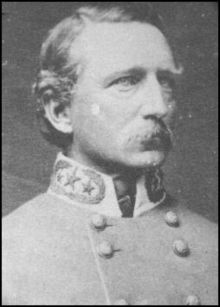Joseph B. Kershaw
Joseph Brevard Kershaw | |
|---|---|
 | |
| Born | January 5, 1822 Camden, South Carolina |
| Died | April 13, 1894 (aged 72) Camden, South Carolina |
| Buried | Quaker Cemetery Camden, South Carolina |
| Allegiance | |
| Service/ | |
| Years of service | 1861–65 (CSA) |
| Rank | |
| Battles/wars | American Civil War |
Joseph Brevard Kershaw (January 5, 1822 – April 13, 1894) was a lawyer, judge, and a Confederate general in the American Civil War.
Early life
Kershaw was born at Camden, South Carolina, admitted to the bar in 1843, and was a member of the South Carolina Senate from 1852 to 1856. Kershaw saw battle during the Mexican-American War, but fell dangerously sick and was permitted to return home.
Civil War
At the start of the Civil War Kershaw commanded the 2nd South Carolina Infantry Regiment and took part in the First Battle of Bull Run. His 2nd Palmetto Regiment was present at Morris Island during the Fort Sumter incident. He was commissioned brigadier general on February 13, 1862, and commanded a brigade in Robert E. Lee's Army of Northern Virginia during the Peninsula Campaign, at the close of which he continued with Lee and took part in the Northern Virginia Campaign and Maryland Campaign. Towards the end of the Battle of Fredericksburg, he succeeded Brig. Gen. T. R. R. Cobb, upon the latter's death, and repulsed the last two attacks made by the Federals on Marye's Heights.
The next year he was engaged in the Battle of Gettysburg and then was transferred with Lt. Gen. James Longstreet's corps to the West, where he took part in the charge that destroyed the Federal right wing at Chickamauga. After the relief of McLaws following the battle of Knoxville Kershaw was given the command of the division. When Longstreet returned to Virginia, he commanded a division in the battles of the Wilderness, Spotsylvania Court House, and Cold Harbor, and was engaged in the Shenandoah campaign of 1864 against Maj. Gen. Philip Sheridan. After the evacuation of Richmond, his troops formed part of Lt. Gen. Richard S. Ewell's corps, which was captured at the Battle of Sayler's Creek, April 6, 1865.
Postbellum career
At the close of the war he returned to South Carolina and in 1865 was chosen president of the State Senate. He was judge of the Circuit Court from 1877 to 1893. In 1894 he was appointed postmaster of Camden, an office that he held until his death in the same year.Joseph B. Kershaw was also Grand Master of the Freemasons of South Carolina. He died in Camden and is buried there in the Quaker Cemetery.[1]
- This article incorporates text from a publication now in the public domain: Gilman, D. C.; Thurston, H. T.; Moore, F., eds. (1905). Kershaw, Joseph Brevard (1822–1894), Volume 11, p. 462. New International Encyclopedia (1st ed.). New York: Dodd, Mead.
See also
Notes
- ^ Eicher, p. 331.
References
- Eicher, John H., and David J. Eicher, Civil War High Commands. Stanford: Stanford University Press, 2001. ISBN 978-0-8047-3641-1.
- Sifakis, Stewart. Who Was Who in the Civil War. New York: Facts On File, 1988. ISBN 978-0-8160-1055-4.
- Warner, Ezra J. Generals in Gray: Lives of the Confederate Commanders. Baton Rouge: Louisiana State University Press, 1959. ISBN 978-0-8071-0823-9.
